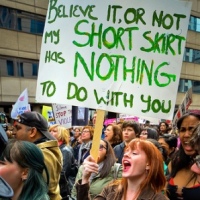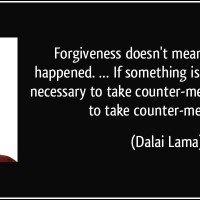 The following are philosopher Martha Nussbaum’s criteria for objectification, that is, the act of treating a person as an object:
The following are philosopher Martha Nussbaum’s criteria for objectification, that is, the act of treating a person as an object:
instrumentality: the treatment of a person as a tool for the objectifier’s purposes;
denial of autonomy: the treatment of a person as lacking in autonomy and self-determination;
inertness: the treatment of a person as lacking in agency, and perhaps also in activity;
fungibility: the treatment of a person as interchangeable with other objects;
violability: the treatment of a person as lacking in boundary-integrity;
ownership: the treatment of a person as something that is owned by another (can be bought or sold);
denial of subjectivity: the treatment of a person as something whose experiences and feelings (if any) need not be taken into account.
To which Professor Rae Langton, MIT, adds the following:
reduction to body: the treatment of a person as identified with their body, or body parts;
reduction to appearance: the treatment of a person primarily in terms of how they look, or how they appear to the senses;
silencing: the treatment of a person as if they are silent, lacking the capacity to speak.
The criteria all refer to the treatment of a person. From this I understand that objectification is enacted in encounters between people, when one party behaves towards the other as if she or he is a means to an end, and not a human being who is entitled to have her or his needs and feelings taken into account.
∫
There’s an almost constant stream of allegations of objectification through sexualisation currently being made in Western society. These are leveled by concerned citizens against much popular culture, and based largely on images of women that culture produces. These allegations presume an objectifying gaze, that is, they insist the viewer will inevitably reduce women portrayed in certain ways to objects to be used for sexual gratification, rather than seeing them as equal human beings. Clothing, facial expressions and postures are used as signifiers of objectification, as well as language.
The signifiers chosen by concerned citizens are based on a Judeo-Christian perception of the adult female body as unruly, dangerous and indecent, and requiring concealment except in specific circumstances such as marriage and other committed monogamous relationships. Clothing that reveals too much of the body’s “private” zones is regarded as transgressing moral codes, as are postures and language that imply female sexual desire, and/or stimulate male “lust.”
Here I should note that the objectification debate is heteronormative. Apparently gays and lesbians don’t objectify each other or if they do, concerned citizens don’t include this in their ambit.
To interpret the clothing, postures and movements as indecent one must first have a particular set of moral values. Otherwise the image will be attractive, unattractive or entirely uninteresting, and it will carry no moral weight.
An image may invite the objectifying gaze. The viewer may accept. However, it’s a big leap to assume that all viewers who find an image “sexy” will inevitably progress from that opinion to objectifying a woman the next time he or she is face to face with one, and will inevitably set about finding ways to use the woman as a means to an end. This assumption imbues the image with nothing less than supernatural powers, as well as denying the viewer’s autonomy and self-determination. It also denies the viewer agency. It denies the viewer’s subjectivity and it also silences the viewer by imposing another’s values on the viewer’s gaze. According to Nussbaum, these are all acts of objectification. In other words, when concerned citizens make these assumptions, they treat the viewer as less human than themselves.
An image can invite us to objectify, but it can’t cause an objectifying consciousness to develop where it previously did not exist.
The inability to perceive others as human like oneself is a symptom of several psychological disturbances, as well as immaturity. These factors are not brought about through viewing an image, and they will not be resolved by removing an image from public view.
∫
The argument that women choose to display their bodies in these ways holds little credence with concerned citizens. The most frequent response is that women don’t understand they’re inviting objectification through presenting their bodies to the admiring and at times desirous male gaze. Another argument is that society (patriarchy) has so “normalised” the objectification of women that only those policing it will notice when it’s happening.
It’s something of a leap to assert that a woman is, without any awareness or agency, issuing an invitation to men to turn her into an object when she steps in front of a camera in small clothes, or plays football in lingerie. I can think of many reasons why women choose to undertake these activities dressed in these ways, and none of them are to do with the kind of compulsive masochism implied in their critics’ interpretations of their actions.
Indeed, such an attitude towards a woman could be read in Nussbaum’s criteria as treating her as if she is lacking in autonomy and self-determination, and treating her as a person lacking in agency. It also denies her subjectivity, and attempts to silence her by imposing an interpretation other than her own on her actions. In other words, the concerned citizens are engaged in objectifying her.
∫
It seems to me that the entire objectification movement is an attempt to impose a particular set of moral values on society. Notions of propriety, largely middle class, are disturbed for example, by the spectacle of women playing football in lingerie. This discomfort is pathologised as objectification, and extrapolated as threatening to all women and girls, who as a consequence of the LFL will be regarded as nothing more than sex objects for male gratification. While there certainly are males who act as if this is their opinion of women, the majority do not. The majority of people understand there is a difference between personal encounters, and imagery.
The charge of objectification is a serious one. It should not be trivialized to serve a moral agenda.
It seems obvious to me that the key to accepting the human right of others not to be treated as a means to an end, lies in education and not censorship. Attempting to build a society on the assumption that all its members are possessed of an objectifying consciousness and everything possible must be done to prevent them indulging that consciousness seems to me insane, and asking for trouble. Respect and value for others as equals is an acquired skill, and we depend on caregivers to instruct our young in acquisition and practice. It’s a work in progress for the human race. Concerned citizens would do better to apply themselves to encouraging and assisting this work, rather than attempting to impose a moral code that adds nothing at all to the civilizing project. An attempt that in its practice commits the very offences it claims to vehemently oppose.








































Recent Comments